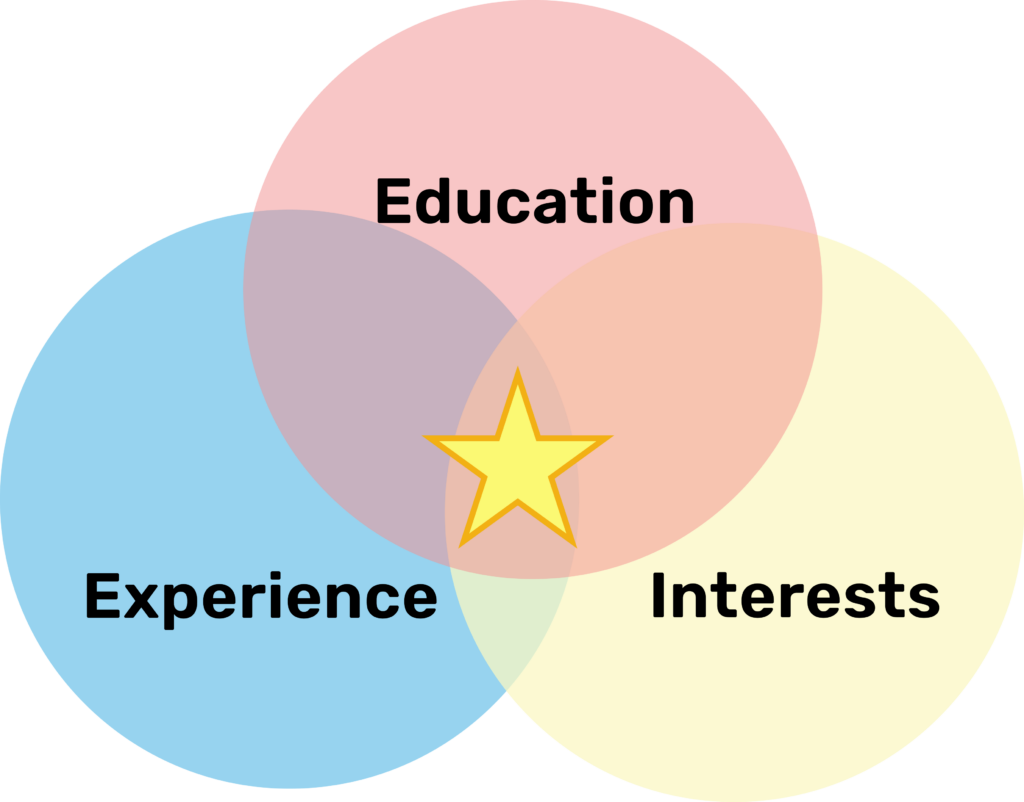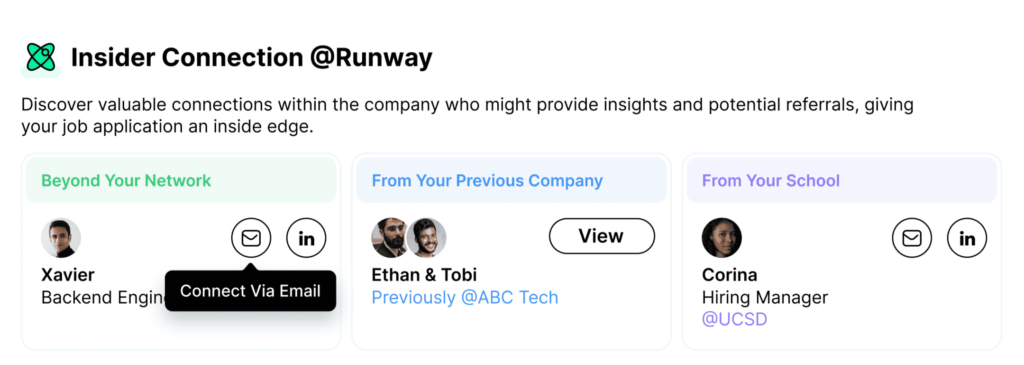How to Choose and Successfully Obtain Your First Job

Table of Contents
Hello to all students who are currently seeking internships or are about to graduate!
As graduation approaches, career choices can feel overwhelming. Today, we will delve into how to choose your first internship or full-time job and how to successfully secure that position.
The content of this blog is all derived from Nick’s speech at the Jobright Event.
Who is Nick?
- 18 Y.O. – Recruitment Chair
- Studied: Econ → Communications + Sociology, Philosophy, Psychology, Physics, Music, Marketing, Entrepreneurship
- 21 Y.O. – Golden State Warriors + Nba.com, NetScouts
- 22 Y.O – Recruiter, Apex Systems
- 23 Y.O. – LinkedIn
- 26 Y.O. – Interview Kickstart
- 33 Y.O. -Jobright

How Should You think About Your First Role?
Finding the Best Intersection
The main personal factors influencing job choices
- Professional and Educational Background
- Internships, Personal Projects
- Interests and Motivation

The intersection of these factors represents the optimal area for applying for jobs.
For Example
If you have studied computer science, particularly data science or machine learning, and have relevant health project experience, applying for a position as a data scientist or machine learning engineer at a healthcare company would be the best choice. Of course, other fields such as retail companies can also be considered, as long as the positions are related to data science.
Choosing the Right Industry
Different industries have different impacts on your career. The tech industry is usually characterized by high levels of innovation, rapid growth, intense competition, and potentially poor work-life balance. However, it also offers great potential and high salaries. Industries such as retail, healthcare, and finance also have technical positions, but they tend to innovate more slowly and are more regulated. Each industry has its pros and cons, and it is crucial to choose the one that aligns with your interests and career goals.
Understanding the Relationship Between Company Size and the Work
The size of a company is important because companies of different sizes have varying impacts on your career.
- Small Companies: These typically prioritize learning a broader range of skills, which are not just purely technical but also about running a business and understanding customers.
- Large Companies: These usually focus more on process orientation and maintaining consistent best practices and high quality.
- Medium-Sized Companies: These fall in between, offering a better balance and more growth opportunities.
Regardless of the company size you choose, you should consider what skills and experiences you want to learn and how these skills and experiences will help you succeed in your career.
It is important to determine your priorities:
- What do you want to learn?
- On which projects do you want to develop your skills?
- What kind of high-impact do you want to achieve in your career?
Brand is also a factor to consider. Having the brand of a well-known company on your resume can open up more opportunities in the future.
You don’t need to have it in your first job, but it’s best to have such a brand on your resume within the first five years of your career.
Aligning With a Company’s Culture and Values That Suit You
Culture is not just about work-life balance; it’s about finding a culture that aligns with your values and strengths.
Nick’s Experience
When I worked at LinkedIn, it was partly because it aligned with my mission and partly because of its great work-life balance. However, I found myself being very persistent in problem-solving and innovation, which sometimes didn’t match the company’s culture. On the contrary, at Interview Kickstart, my persistence was rewarded.
Therefore, it’s crucial to find a company whose culture and values align with yours. Consider these factors to find the company that best suits you.
The core question to ask yourself
What does this decision mean for the next three to five years of my career? If I consider the industry, company size, culture, and how these align with my strengths and weaknesses, where will I be in three to five years? Does this position align with my career plans for the next three to five years?
How Do You Get Your First Job?
Main Methods for Obtaining a Job:
- Apply= high volume, low conversion rote
- Network= low volume, high conversion rote
How to Improve the Efficiency of Job Applications?
Applying for jobs is a numbers game; it requires a high volume of applications but has a low conversion rate. Therefore, it is recommended to apply for multiple positions each week and not to get discouraged by a lack of responses.
You can upload your resume to Jobright and use resume parsing to find high-probability positions.
You can also improve your success rate by customizing your resume. For example, modify the content of your resume to better match the job requirements.
Spend half an hour each day, over a few days, concentrating on applying for positions to ensure you apply for multiple jobs each week.
When looking for your first job, expect a low response rate, as this is normal. Therefore, it is important to keep applying consistently to give yourself more opportunities.
How to Gain More Information and Ultimately Get Referral Opportunities Through Networking?
- Do not directly ask for a referral. Most people make the common mistake of asking their contacts for a referral right away. Instead, use these opportunities to learn and gain more insights.
- When reaching out, mention your commonalities with the contact and express interest in their experiences. Ask about their experience working at the company.
- During the information exchange, inquire about the key factors for success at the company and the qualities and skills needed at your career stage.
How to Ask Meaningful Questions in Information Exchanges to Demonstrate Your Ability and Fit?
At the end of the conversation, you can ask a key question: “What makes someone at my career stage successful in your company?”
The purpose of this question is threefold:
- To confirm if you are truly a good fit for the company.
- To prepare for the upcoming interview and ensure you can effectively present yourself.
- To see if your experience and skills align with their needs.
After they respond, you can naturally mention your relevant experiences and projects and ask if these align with the success factors they mentioned.
Finally, if they think you are a good fit, you can ask if they could introduce you to the recruiter to gain a referral opportunity.
Sample Question
Industry-related questions: Why did you choose this company or industry? What attracted you to it?
Company stage-related questions: How do you see the future direction of the company? Do you have confidence in the company’s leadership and roadmap?
Culture-related questions: What behaviors and values are rewarded in this company? How do these impact your career development?
Tips: When trying to contact someone through LinkedIn, use the following method to find more information about them, so you can better express commonalities.
- Search for the person’s name and company.
For example, if you are looking for David. who works at People Data Labs, you can enter “David. AND People Data Labs” in the LinkedIn search bar.
This will help you find all the people associated with that name and company, ensuring you have found the correct person.
- Once you find them, you can contact them directly through LinkedIn.
If you have their phone number, you can also send them a text message.
By using this method, you can better understand your connection with them and establish a stronger contact.
Best Strategies: Apply + Network = Jobright + LinkedIn
- Upload your resume on Jobright and use Jobright’s filter to find jobs that match your position.

- Jobright will calculate the match degree between you and your target job based on your situation. You can set the priority for your applications according to the match degree.

- You can see how to contact the internal staff of this company on the job details page.

Finding a Job with Like-minded Friends
Early core members of PayPal, such as Elon Musk, Reid Hoffman, and Peter Thiel, collaborated to fund and establish many well-known companies in Silicon Valley.
Nick suggests that if you have friends with similar ambitions, you can prepare for interviews together, help each other with informational interviews, and share opportunities.
Nick said, “If you want to go fast, go alone; if you want to go far, go together.”

Q&A
How to Choose Between Different Types of Companies?
It is recommended to talk to employees from different types of companies in the industry to understand their work content and lifestyle.
Choose the type of company that best suits your interests and career goals.
How to Understand the Work Characteristics and Lifestyle of Employees in Companies of Different Sizes and Stages?
Try to communicate with employees from companies of different sizes (e.g., large companies, medium-sized companies, and startups) and different stages (e.g., pre-IPO, newly listed).
Understand the industry these companies belong to, as different industries can have varying impacts on work characteristics and lifestyle.
How to Ask Company Employees Questions for In-Depth Understanding?
Work Content: Ask about their daily work, what aspects they find most appealing, and which aspects they dislike.
Lifestyle: Learn about their work-life balance, and how work affects their family, friends, and personal health.
Work Environment: Ask about their work environment, and whether it supports their healthy habits and lifestyle.
How to Write a Cold Email?
Start with commonality, then express appreciation, and finally make a request. We can call this the CAA method.
Commonality, You may have heard the phrase, “Birds of a feather flock together.” There is actual psychological basis for this. When someone is similar to us in many ways, such as values, place of origin, educational background, religion, cultural background, and interests, it brings a sense of safety. Because we understand them, it reduces the fear of the unknown.
First, you need to establish commonality, compliment something you like about them, such as their profile or something they posted, and then make a request to see if you can have a conversation. This is the basic template, and you can use ChatGPT to find more different templates, but this is the most effective basic process I’ve seen. While it won’t have a 100% response rate, if you can achieve a 15% to 25% response rate, that is very good. This accounts for people who are not very active on LinkedIn, very busy people, and those who see the message but don’t have the time or interest to respond. But if your template has a response rate of 15% to 25%, keep using it. Stick to this template.
